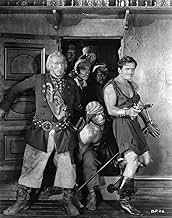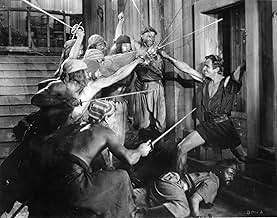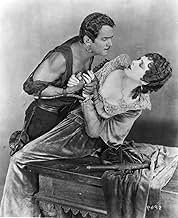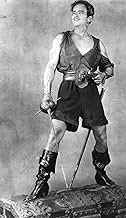NOTE IMDb
7,0/10
2,3 k
MA NOTE
Ajouter une intrigue dans votre langueSeeking revenge, an athletic young man joins the pirate band responsible for his father's death.Seeking revenge, an athletic young man joins the pirate band responsible for his father's death.Seeking revenge, an athletic young man joins the pirate band responsible for his father's death.
- Réalisation
- Scénario
- Casting principal
- Récompenses
- 3 victoires au total
Douglas Fairbanks
- The Duke of Arnoldo
- (as Mr. Douglas Fairbanks)
- …
Billie Dove
- Princess Isobel
- (as Miss Billie Dove)
Tempe Pigott
- Duenna
- (as Miss Tempé Pigett)
Donald Crisp
- MacTavish
- (as Mr. Donald Crisp)
Sam De Grasse
- Pirate Lieutenant
- (as Mr. Sam de Grasse)
Anders Randolf
- Pirate Captain
- (as Mr. Anders Randolf)
Charles Stevens
- Powder Man
- (as Mr.Charles Stevens)
John Wallace
- Peg-Leg Pirate
- (as Mr. John Wallace)
Fred Becker
- Pirate
- (as Mr. Fred Becker)
Charles Belcher
- Chief Passenger - Nobleman
- (as Mr. Charles Belcher)
E.J. Ratcliffe
- The Governor
- (as Mr. E. J. Ratcliffe)
Jimmy Dime
- Pirate
- (non crédité)
George Holt
- Pirate
- (non crédité)
Dave Kashner
- Pirate
- (non crédité)
Stubby Kruger
- Pirate
- (non crédité)
Charles Lewis
- Pirate
- (non crédité)
Barry Norton
- Youth
- (non crédité)
Avis à la une
THE BLACK PIRATE (1926) tells the story of a mysterious figure (Douglas Fairbanks) who survives a pirate raid. Sworn to avenge his dead father, he takes command of the pirates responsible, and secretly strives to free the princess whom they have kidnapped. A power-hungry lieutenant who tries to incite the men against him complicates his plans. Directed by Albert Parker.
The script is quite interesting, following The Black Pirate's skillful command of his pirate band, as well as his resourcefulness and ingenuity. The scenario offers plenty of action – pirate raids, duels, underwater photography – as well as a little bit of rather unlikely romance that always seems to pop up in films like these.
Perhaps the greatest cinematographic interest is provided by the film's use of two-strip Technicolor. There are some lovely sweeping shots of the ocean and the ships at sea. The film could benefit from more dynamic editing and variety between close-ups and long shots during the other scenes, though. The camera work feels very restrained for much of the film's running time, as if the crew were aiming to evoke the tableaux style of earlier films. In my opinion this diluted the impact of the action scenes and caused the film to feel somewhat detached. The direction of the movie was competent rather than brilliant, and greater use of the cinematographic resources available at the time would have given the film more impact. After all, this was made in 1926, after such pioneering classics as THE LAST LAUGH and BATTLESHIP POTEMKIN. However, there were very dynamic moments as well, mostly due to the stunt work.
THE BLACK PIRATE boasts fine performances, particularly by the charismatic and athletic Fairbanks, as well as by Sam de Grasse, the lieutenant who chafes under The Black Pirate's leadership. There's a scene where the Black Pirate takes over a ship by himself, and the athleticism shown by Fairbanks is astounding. Billie Dove plays a fairly typical damsel in distress type as the Princess.
Overall, THE BLACK PIRATE is entertaining, but it could have packed more of a punch with more imaginative direction. However, the color cinematography is generally lovely to look at, and Fairbanks gives a splendid performance. SCORE: 7/10
The script is quite interesting, following The Black Pirate's skillful command of his pirate band, as well as his resourcefulness and ingenuity. The scenario offers plenty of action – pirate raids, duels, underwater photography – as well as a little bit of rather unlikely romance that always seems to pop up in films like these.
Perhaps the greatest cinematographic interest is provided by the film's use of two-strip Technicolor. There are some lovely sweeping shots of the ocean and the ships at sea. The film could benefit from more dynamic editing and variety between close-ups and long shots during the other scenes, though. The camera work feels very restrained for much of the film's running time, as if the crew were aiming to evoke the tableaux style of earlier films. In my opinion this diluted the impact of the action scenes and caused the film to feel somewhat detached. The direction of the movie was competent rather than brilliant, and greater use of the cinematographic resources available at the time would have given the film more impact. After all, this was made in 1926, after such pioneering classics as THE LAST LAUGH and BATTLESHIP POTEMKIN. However, there were very dynamic moments as well, mostly due to the stunt work.
THE BLACK PIRATE boasts fine performances, particularly by the charismatic and athletic Fairbanks, as well as by Sam de Grasse, the lieutenant who chafes under The Black Pirate's leadership. There's a scene where the Black Pirate takes over a ship by himself, and the athleticism shown by Fairbanks is astounding. Billie Dove plays a fairly typical damsel in distress type as the Princess.
Overall, THE BLACK PIRATE is entertaining, but it could have packed more of a punch with more imaginative direction. However, the color cinematography is generally lovely to look at, and Fairbanks gives a splendid performance. SCORE: 7/10
I knew little of this film before watching it, but am glad I found it. It's an excellent early film about a group of cutthroats. The thing that surprised me the most was that it was in color. It was filmed using the experimental two-color technicolor process. After watching the "Making of", apparently Douglas fairbanks was a real pioneer in that area and did much research on color film. This was my first Fairbanks film and I was quite impressed with not only his screen presence, but his ability to do impressive stuntwork, including the infamous sliding down a sail on a knife. This film had all the requirements of a pirate movie... Swordplay, torture, murder, robbery, kidnapping, romance, and even walking the plank. As well as the infamous quote, "Dead men tell no tales!". It had a decent score by Mortimer Wilson that was mostly fitting. One scene I found amusing, was when the pirates drew lots for the monkey. If you're a fan of pirate movies, this is a must see. I found it quite enjoyable.
*** (out of 4)
*** (out of 4)
A nobleman vows vengeance on the cutthroats responsible for his father's death. Becoming THE BLACK PIRATE, he joins their scurvy crew and quickly becomes their leader. But his plans for revenge become more complicated when he meets his first captive - a beautiful Spanish princess.
Roistering, robust & richly detailed, this was one of Douglas Fairbanks' greatest films. With enough excitement to satisfy any lover of adventure, one needs only read the film's prologue to get an idea of its delights: 'A page from the History and Lives of the most Bloodthirsty PIRATES who ever infested THE SOUTHERN SEAS. Being an account of BUCCANEERS & the Spanish MAIN, the Jolly Roger, Golden Galleons, bleached skulls, BURIED TREASURE, the Plank, dirks & cutlasses, SCUTTLED SHIPS, marooning, DESPERATE DEEDS, DESPERATE MEN, and - even on this dark soil - ROMANCE.' Aside from the bleached skulls, everything else is there as promised
Fairbanks is a joy to behold, exulting in his physical prowess, becoming a legend of the screen before the delighted eyes of the viewer. Can any other swashbuckler top the flair or élan of the sequence where Doug captures a merchantman single-handed, climbing up the forecastle & sliding down the slit sails on his dagger, light as any sprite? No one else would have even dared.
As the princess, Billie Dove is beautiful, but has very little to do except look frightened. Donald Crisp, in a change of pace role, is very enjoyable as a gruff one-armed Scots pirate who befriends Fairbanks. Anders Randolf & Sam De Grasse are the black-hearted pirate captain & lieutenant whom Doug must contend with and they are nasty indeed.
A milestone in cinematic history, this was one of the first movies to be filmed entirely in Technicolor. In its restored version, it is very pleasant to the eyes, its antique hues perfectly complementing the richly textured art design, costumes & sets.
For those interested in such things, there are explanations for the various special effects (the underwater attack, for instance), but the reader will need to look elsewhere for them. Sometimes too many facts can spoil the illusion of daydreams so necessary for the enjoyment of silent cinema. Find this fabulous film & dream on.
Too bad about the bleached skulls, though...
Roistering, robust & richly detailed, this was one of Douglas Fairbanks' greatest films. With enough excitement to satisfy any lover of adventure, one needs only read the film's prologue to get an idea of its delights: 'A page from the History and Lives of the most Bloodthirsty PIRATES who ever infested THE SOUTHERN SEAS. Being an account of BUCCANEERS & the Spanish MAIN, the Jolly Roger, Golden Galleons, bleached skulls, BURIED TREASURE, the Plank, dirks & cutlasses, SCUTTLED SHIPS, marooning, DESPERATE DEEDS, DESPERATE MEN, and - even on this dark soil - ROMANCE.' Aside from the bleached skulls, everything else is there as promised
Fairbanks is a joy to behold, exulting in his physical prowess, becoming a legend of the screen before the delighted eyes of the viewer. Can any other swashbuckler top the flair or élan of the sequence where Doug captures a merchantman single-handed, climbing up the forecastle & sliding down the slit sails on his dagger, light as any sprite? No one else would have even dared.
As the princess, Billie Dove is beautiful, but has very little to do except look frightened. Donald Crisp, in a change of pace role, is very enjoyable as a gruff one-armed Scots pirate who befriends Fairbanks. Anders Randolf & Sam De Grasse are the black-hearted pirate captain & lieutenant whom Doug must contend with and they are nasty indeed.
A milestone in cinematic history, this was one of the first movies to be filmed entirely in Technicolor. In its restored version, it is very pleasant to the eyes, its antique hues perfectly complementing the richly textured art design, costumes & sets.
For those interested in such things, there are explanations for the various special effects (the underwater attack, for instance), but the reader will need to look elsewhere for them. Sometimes too many facts can spoil the illusion of daydreams so necessary for the enjoyment of silent cinema. Find this fabulous film & dream on.
Too bad about the bleached skulls, though...
Seeking revenge, an athletic young man joins the pirate band responsible for his father's death.
"The Black Pirate" was the third feature to be filmed in an early two-tone Technicolor process that had been first introduced in the 1922 feature "Toll of the Sea". This reproduces a limited but pleasing range of colors. "Ben-Hur", filmed around the same time, contains two-tone sequences but is shot primarily in black-and-white with tinting and toning in many scenes.
This is really a defining film in the career of Douglas Fairbanks. I mean, really, it is closing in 100 years later and he is still remembered as a swashbuckler. This is the very definition of a swashbuckler film. And the color! I couldn't say much about the two-color process, but I think this looks phenomenal.
"The Black Pirate" was the third feature to be filmed in an early two-tone Technicolor process that had been first introduced in the 1922 feature "Toll of the Sea". This reproduces a limited but pleasing range of colors. "Ben-Hur", filmed around the same time, contains two-tone sequences but is shot primarily in black-and-white with tinting and toning in many scenes.
This is really a defining film in the career of Douglas Fairbanks. I mean, really, it is closing in 100 years later and he is still remembered as a swashbuckler. This is the very definition of a swashbuckler film. And the color! I couldn't say much about the two-color process, but I think this looks phenomenal.
Douglas Fairbanks Snr., can quite fairly be given credit for the first movie action star. 'The Black Pirate' has a number of sequences which highlight his magnificent athletic ability. I found myself marveling at the extended sequence where he seizes a merchant ship singlehandedly. What strength and skill, what agility and courage! I loved watching him scale the stern of the ship and was extremely impressed by his cutting open of the sails from top to bottom with a knife. Some of the work was quite funny and you could tell that the filmed footage was being shown in reverse but that doesn't stop the stunts themselves from being extremely entertaining. He's got more guts than me, I'll say that much!
'The Black Pirate' is difficult to evaluate. Do we grade a film based upon:
a) other pirate films b) silent films c) on a general level of enjoyment against all films
As a silent film, and for that matter a two strip Technicolor silent film, 'The Black Pirate' is a landmark for innovation. Fairbanks had misgivings about the use of colour but felt a pirate film MUST be shown in colour. He gets great benefit. There is a great deal of implied violence (duh, a pirate film!) and the bright red colour of blood is almost shocking to see. There's a scene where a captive tries to hide a ring he's wearing by swallowing it. Unfortunately for him he's seen. After a little off camera ... searching... for the ring, a pirate presents a bloodied ring in bloodied hands as he wipes a bloodied dagger on his tunic to the captain. Pretty thrilling stuff for the 1920's. This was also a film where very serious philosophy and training were put to great effect with the fencing. You can see how it out-steps a lot of earlier swordplay films and influenced the style in films that would follow. According to film historian Rudy Behlmer on an excellent commentary track with the Kino DVD, the fencing master hired by Fairbanks became a staple of the industry. Many of the great sword fight movies from the next 25 years were his handiwork -- including 'The Adventures of Robin Hood,' and 'Captain Blood.'
Against other pirate films, 'The Black Pirate' has perhaps more value as a curiosity. Even by the late 1930's and 40's it was being outdistanced by Errol Flynn films like 'Captain Blood' and 'The Seahawk,' Tyrone Power in 'The Black Swan,' or Burt Lancaster in 'The Crimson Pirate.' Today it gets totally wiped off the board by the 'Pirates of the Caribbean' series. Though still fun to watch, these later films are better and more enjoyable.
This is definitely worth tracking down on the Kino DVD if you can find it. Rudy Behlmer has an excellent commentary track that is of great value to people who are interested in early Hollywood and Douglas Fairbanks. I recommend it highly for the student or the general enthusiast based upon that reason. And it is a good movie to! 'The Black Pirate' has a great sense of adventure to it with thrilling stunt work. Silent movie fans shouldn't be disappointed. Fans of pirate movies should give it a try to see what helped popularize the genre.
'The Black Pirate' is difficult to evaluate. Do we grade a film based upon:
a) other pirate films b) silent films c) on a general level of enjoyment against all films
As a silent film, and for that matter a two strip Technicolor silent film, 'The Black Pirate' is a landmark for innovation. Fairbanks had misgivings about the use of colour but felt a pirate film MUST be shown in colour. He gets great benefit. There is a great deal of implied violence (duh, a pirate film!) and the bright red colour of blood is almost shocking to see. There's a scene where a captive tries to hide a ring he's wearing by swallowing it. Unfortunately for him he's seen. After a little off camera ... searching... for the ring, a pirate presents a bloodied ring in bloodied hands as he wipes a bloodied dagger on his tunic to the captain. Pretty thrilling stuff for the 1920's. This was also a film where very serious philosophy and training were put to great effect with the fencing. You can see how it out-steps a lot of earlier swordplay films and influenced the style in films that would follow. According to film historian Rudy Behlmer on an excellent commentary track with the Kino DVD, the fencing master hired by Fairbanks became a staple of the industry. Many of the great sword fight movies from the next 25 years were his handiwork -- including 'The Adventures of Robin Hood,' and 'Captain Blood.'
Against other pirate films, 'The Black Pirate' has perhaps more value as a curiosity. Even by the late 1930's and 40's it was being outdistanced by Errol Flynn films like 'Captain Blood' and 'The Seahawk,' Tyrone Power in 'The Black Swan,' or Burt Lancaster in 'The Crimson Pirate.' Today it gets totally wiped off the board by the 'Pirates of the Caribbean' series. Though still fun to watch, these later films are better and more enjoyable.
This is definitely worth tracking down on the Kino DVD if you can find it. Rudy Behlmer has an excellent commentary track that is of great value to people who are interested in early Hollywood and Douglas Fairbanks. I recommend it highly for the student or the general enthusiast based upon that reason. And it is a good movie to! 'The Black Pirate' has a great sense of adventure to it with thrilling stunt work. Silent movie fans shouldn't be disappointed. Fans of pirate movies should give it a try to see what helped popularize the genre.
Le saviez-vous
- AnecdotesThe double-thick Technicolor prints (two strips of dyed film, cemented together) presented numerous screening problems for untrained projectionists. If screened improperly, they would warp, scratch, etc. and due to the expense of printing in Technicolor at this time (since there were no optical printers, or any easier way of printing such technology in those days) forced the Fairbanks studio to issue a black-and-white version as well.
- GaffesAt about 31 minutes into the film, there are several shots of the "Black Pirate" aiming two swivel cannons at the viewer, interspersed with reaction shots of other actors. The first shot shows him in front of a whitish background (eg an overcast sky), the second such shot (a few seconds later) has a pitch black background. All such shots after that have the white background.
- ConnexionsEdited into Spisok korabley (2008)
Meilleurs choix
Connectez-vous pour évaluer et suivre la liste de favoris afin de recevoir des recommandations personnalisées
- How long is The Black Pirate?Alimenté par Alexa
Détails
Box-office
- Budget
- 1 300 000 $US (estimé)
- Durée1 heure 28 minutes
- Mixage
- Rapport de forme
- 1.33 : 1
Contribuer à cette page
Suggérer une modification ou ajouter du contenu manquant

Lacune principale
By what name was Le pirate noir (1926) officially released in India in English?
Répondre



































